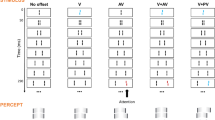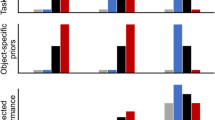Abstract
When one object is partly occluded by another, its occluded parts are perceptually ‘filled in’, that is, the occluded object appears to continue behind its occluder. This process is known as amodal completion1. The completion of a partially occluded object takes about 200 ms (ref. 2), and pre-completion information (that is, information from before amodal completion has occurred) exists in the visual system for that duration2,3. It has been suggested, however, that observers cannot make use of this information, even when it is beneficial to do so: visual search for a target that appears to be partly occluded, for example, is slower than for a target that does not undergo occlusion, despite both targets being physically identical4,5,6. Here we show that visual search does have access to pre-completion representations, but only for a limited time that depends on the size of the occluded region.
This is a preview of subscription content, access via your institution
Access options
Subscribe to this journal
Receive 51 print issues and online access
$199.00 per year
only $3.90 per issue
Buy this article
- Purchase on Springer Link
- Instant access to full article PDF
Prices may be subject to local taxes which are calculated during checkout




Similar content being viewed by others
References
Michotte, A., Thinès, G. & Crabbé, G. in Michotte's Experimental Phenomenology of Perception (eds G. Thinès, A. Costall & G. Butterworth) (Lawrence Erlbaum Associates, Hillsdale, New Jersey, 1991).
Sekuler, A. B. & Palmer, S. E. Perception of partly occluded objects: a microgenetic analysis. J. Exp. Psychol. Gen. 121, 95–111 (1992).
Gerbino, W. & Salmaso, D. The effect of amodal completion on visual matching. Acta Psychol. 65, 25–46 (1987).
He, Z. J. & Nakayama, K. Surfaces versus features in visual search. Nature 359, 231–233 (1992).
Rensink, R. A. & Enns, J. T. Early completion of occluded objects. Vis. Res. 28, 2489–2505 (1998).
Davis, G. & Driver, J. Kanizsa subjective figures can act as occluding surfaces at parallel stages of visual search. J. Exp. Psychol. Hum. Percept. Perform. 24, 169–184 (1998).
Treisman, A. & Gelade, G. A feature integration theory of attention. Cogn. Psychol. 12, 97–136 (1980).
Treisman, A. Preattentive processing in vision. Comp. Vis. Graphics Image Proc. 31, 156–177 (1985).
Wolfe, J. M., Cave, K. R. & Franzel, S. L. Guided search: an alternative to the feature integration model for visual search. J. Exp. Psychol. Hum. Percept. Perform. 15, 419–433 (1989).
Wolfe, J. M. Guided search 2.0: a revised model of visual search. Psychonom. Bull. Rev. 1, 202–238 (1994).
Wolfe, J. M. in Attention (ed. Pashler, H.) 13–73 (Psychology Press, Hove, 1998).
Julesz, B. Textons, the elements of texture-perception, and their interactions. Nature 290, 91–97 (1981).
Donnelly, N., Humphreys, G. W. & Riddoch, M. J. Parallel computation of shape description. J. Exp. Psychol. Hum. Percept. Perform. 17, 561–570 (1991).
Rensink, R. A. & Enns, J. T. Preemption effects in visual search: Evidence for low-level grouping. Psychol. Rev. 102, 101–130 (1995).
Blake, R. What can be ‘perceived’ in the absence of visual awareness? Curr. Dir. Psychol. Sci. 6, 157–162 (1997).
Crick, F. & Koch, C. Are we aware of neural activity in primary visual cortex? Nature 375, 121–123 (1995).
Breitmeyer, B. G. Visual Masking: An Integrative Approach (Oxford Univ. Press, New York, 1984).
Enns, J. T. & Di Lollo, V. What's new in visual masking? Trends Cogn. Sci. 4, 345–352 (2000).
Shore, D. I. & Enns, J. T. Shape completion time depends on the size of the occluded region. J. Exp. Psychol. Hum. Percept. Perform 23, 980–998 (1997).
Wolfe, J. M. & Horowitz, T. S. A new look at preattentive vision. Invest. Ophthal. Vis. Sci. 39, S872 (1998).
Acknowledgements
This work was supported by a grant from the National Institutes of Health. We are grateful to J. Enns and J. Wolfe (who suggested the response-time control experiment) for their comments on an earlier draft.
Author information
Authors and Affiliations
Corresponding author
Rights and permissions
About this article
Cite this article
Rauschenberger, R., Yantis, S. Masking unveils pre-amodal completion representation in visual search. Nature 410, 369–372 (2001). https://doi.org/10.1038/35066577
Received:
Accepted:
Issue Date:
DOI: https://doi.org/10.1038/35066577
This article is cited by
-
Compositional scene modeling with global object-centric representations
Machine Learning (2024)
-
Awareness-independent gradual spread of object-based attention
Current Psychology (2023)
-
Amodal completion and relationalism
Philosophical Studies (2022)
-
Filling the gap despite full attention: the role of fast backward inferences for event completion
Cognitive Research: Principles and Implications (2019)
-
Separate cortical stages in amodal completion revealed by functional magnetic resonance adaptation
BMC Neuroscience (2007)
Comments
By submitting a comment you agree to abide by our Terms and Community Guidelines. If you find something abusive or that does not comply with our terms or guidelines please flag it as inappropriate.



